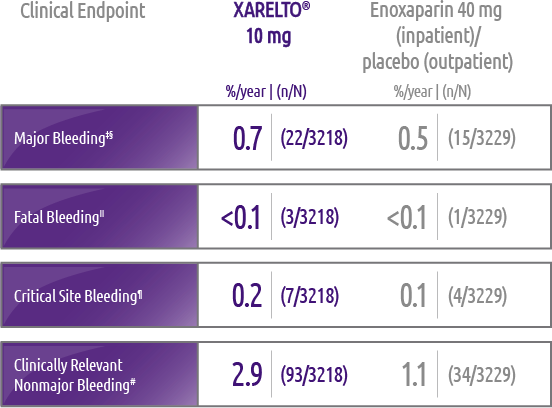For US Healthcare Professionals
XARELTO®: Safety profile of venous thromboembolism (VTE) prophylaxis in acutely ill medical patients◇
Rates of bleeding among acutely ill medical patients at Day 35*
Bleeding events in MAGELLAN subgroup at Day 35†
- ~99% of patients taking XARELTO® did not experience a major bleeding event
- ~97% of patients taking XARELTO® did not experience a clinically relevant nonmajor bleeding event; however, these events were increased with XARELTO® versus SOC

MAGELLAN
Trial design: Randomized, multicenter, double-blind, parallel-group efficacy and safety study comparing XARELTO® with enoxaparin, in the prevention of VTE in hospitalized acutely ill medical patients during the in-hospital and post–hospital-discharge period. Eligible patients included adults who were at least 40 years of age, hospitalized for an acute medical illness, at risk of VTE due to moderate or severe immobility, and had additional risk factors for VTE. The population at risk of VTE was required to have 1 or more of the following VTE risk factors: prolonged immobilization, age ≥75 years, history of cancer, history of VTE, history of heart failure, thrombophilia, acute infectious disease contributing to the hospitalization, and BMI ≥35 kg/m2. The causes for hospitalization included heart failure, active cancer, acute ischemic stroke, acute infectious and inflammatory disease, and acute respiratory insufficiency. Patients were randomized to receive either XARELTO® 10 mg once daily for 35 ±4 days starting in hospital and continuing post hospital discharge (n=4050) or enoxaparin 40 mg once daily for 10 ±4 days starting in hospital followed by placebo post discharge (n=4051).
Primary outcomes: The primary efficacy outcome was a composite endpoint that included asymptomatic proximal DVT in lower extremity, symptomatic proximal or distal DVT in the lower extremity, symptomatic nonfatal PE, and death related to VTE.
◇For VTE prophylaxis in acutely ill medical patients at risk for thromboembolic complications who are not at high risk of bleeding.
*Patients excluded due to high risk of bleeding: history of bronchiectasis, pulmonary cavitation, or pulmonary hemorrhage; active cancer (ie, undergoing acute, in-hospital cancer treatment); active gastroduodenal ulcer in the 3 months prior to treatment; history of bleeding within the last 3 months prior to treatment; or receiving DAPT.
†Patients received either XARELTO® or placebo once daily for 35 days ±4 days starting in hospital and continuing post hospital discharge, or received enoxaparin or placebo once daily for 10 days ±4 days in the hospital.
‡Major bleeding events within each subcategory were counted once per patient, but patients may have contributed events to multiple subcategories. These events occurred during treatment or within 2 days of stopping treatment.
§Defined as bleeding associated with a drop in hemoglobin of ≥2 g/dL, a transfusion of ≥2 units of packed red blood cells or whole blood, bleeding at a critical site, or with a fatal outcome.
ǁFatal bleeding is adjudicated death with the primary cause of death from bleeding.
¶Critical site bleeding was defined as bleeding into a critical site such as intracranial, intraspinal, intraocular, retroperitoneal, intra-articular, pericardial, or intramuscular with compartment syndrome.8
#Clinically relevant bleeding was the primary safety endpoint of the MAGELLAN study and was a composite of major bleeding and clinically relevant nonmajor bleeding. Clinically relevant nonmajor bleeding was defined as overt bleeding not meeting the criteria for major bleeding but associated with medical intervention, unscheduled contact with a physician, temporary cessation of study treatment or discomfort for the patient such as pain, or impairment of activities of daily life.8
**The decision regarding initiation setting should be based on the prescriber's clinical judgment.
BMI = body mass index; DAPT = dual antiplatelet therapy; DVT = deep venous thrombosis; PE = pulmonary embolism; SOC = standard of care; VTE = venous thromboembolism.

